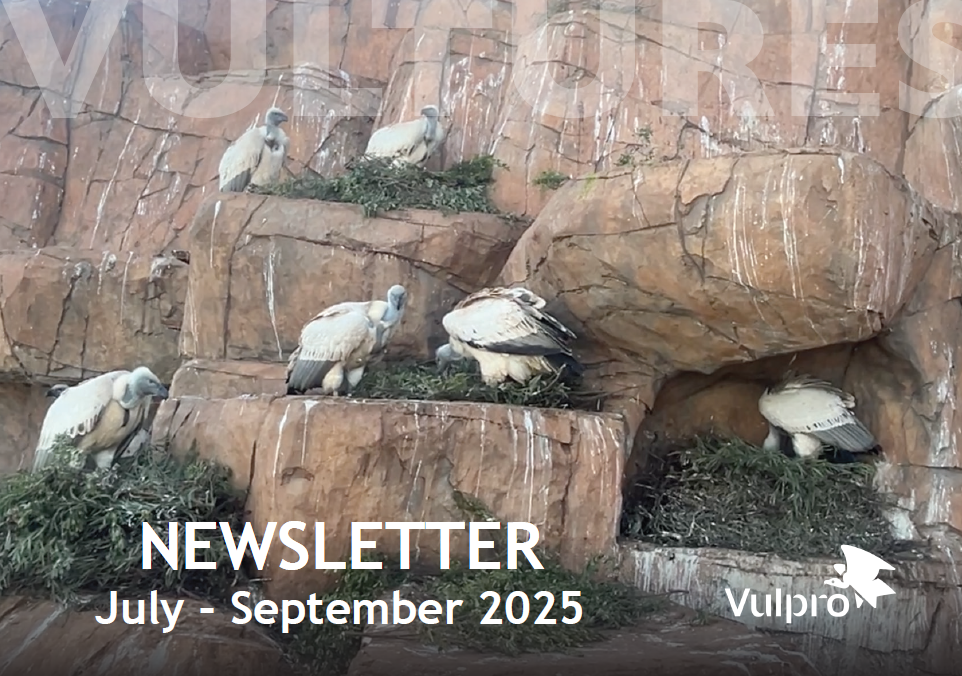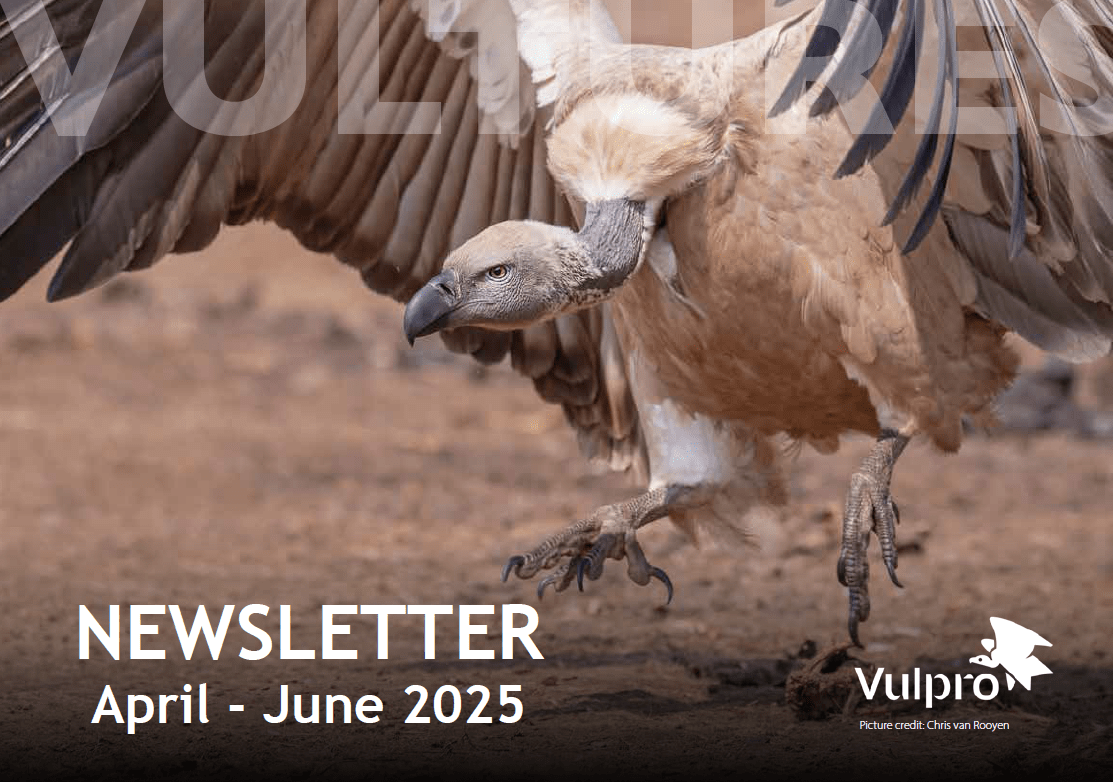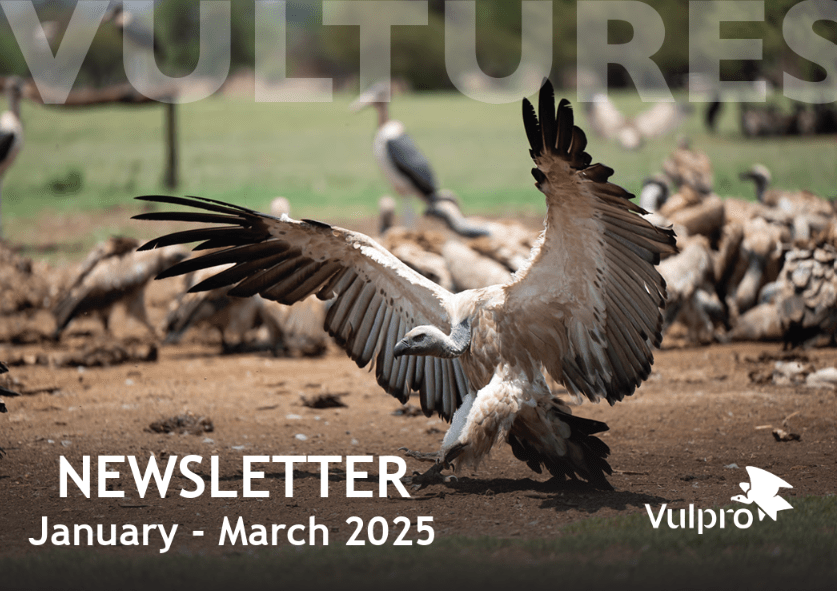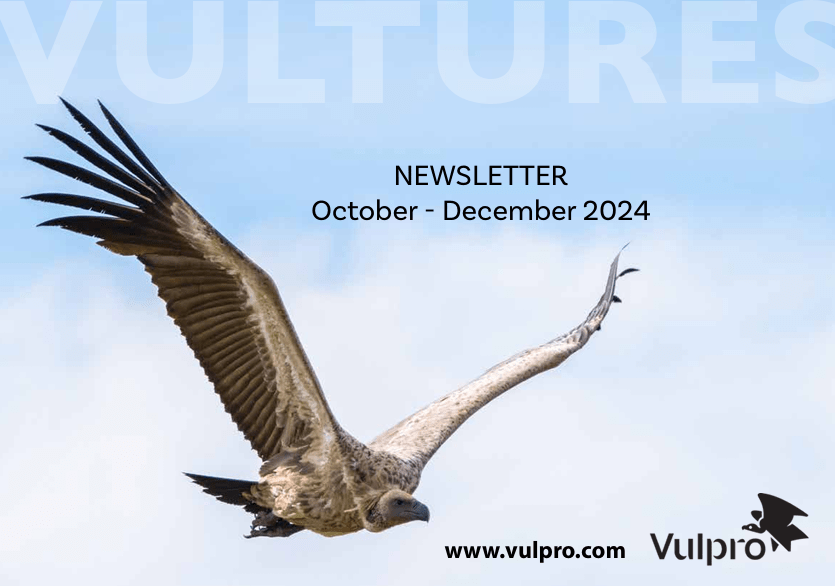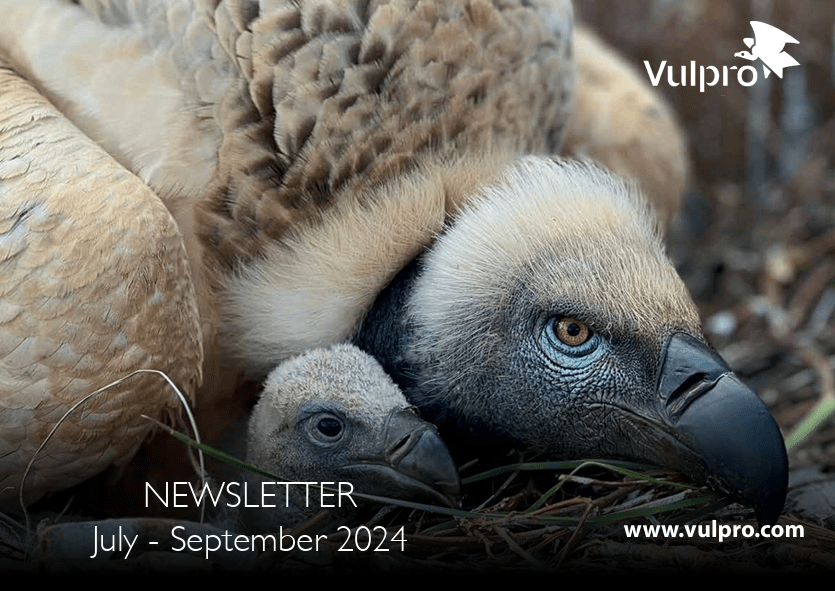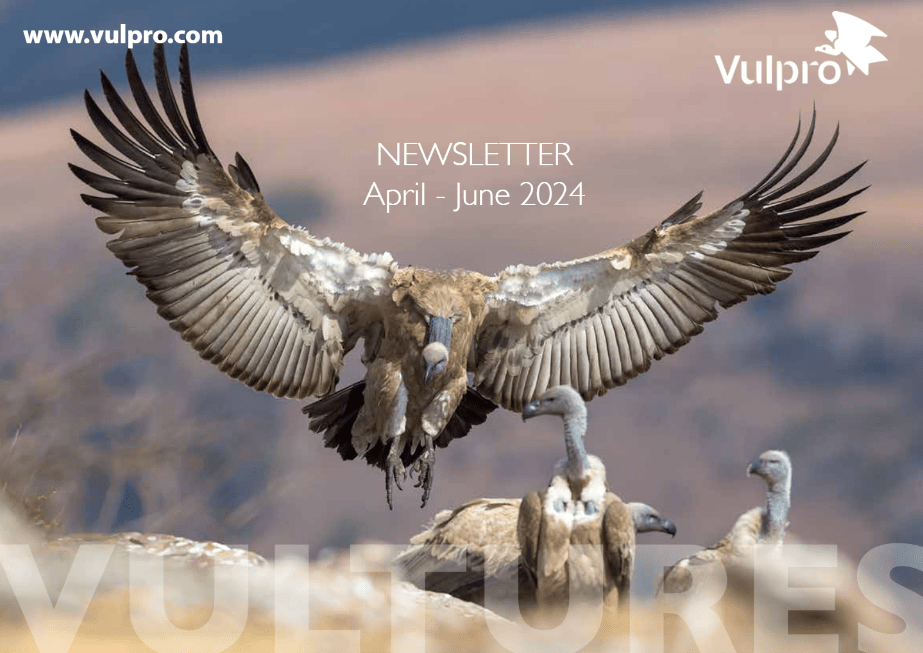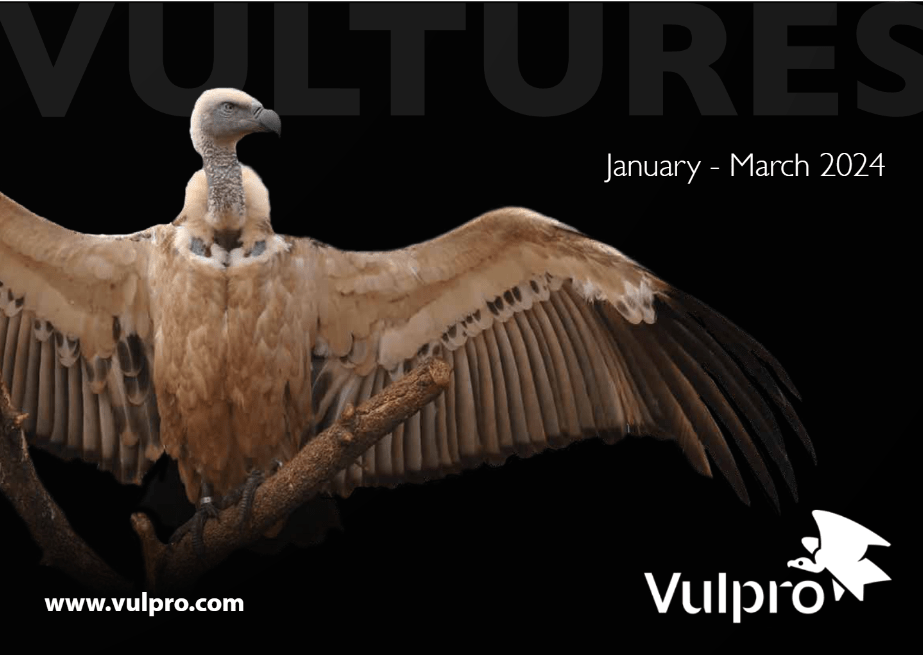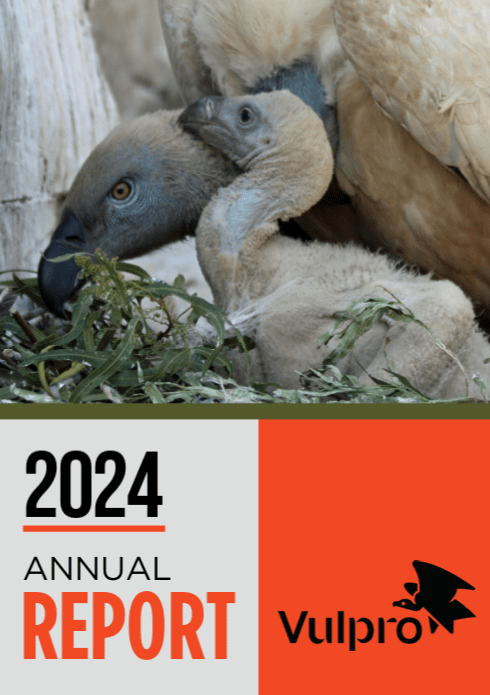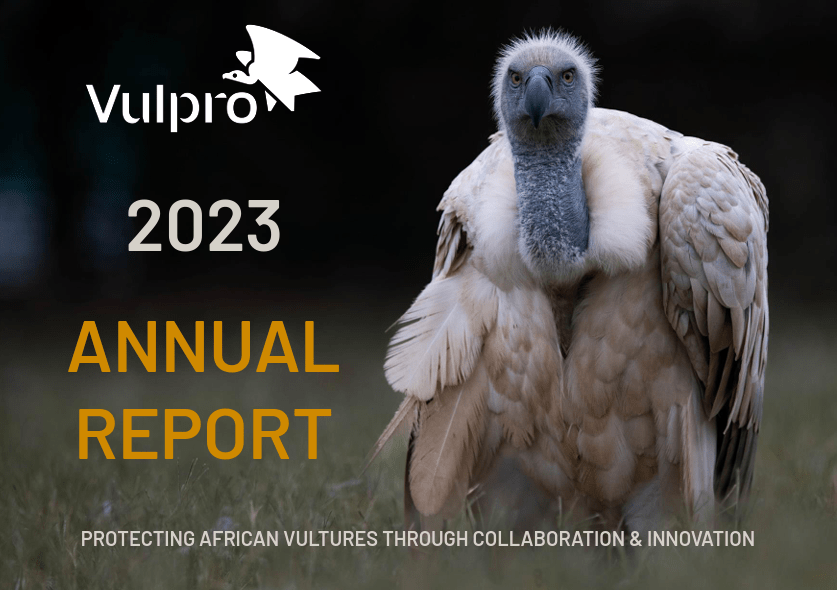Newsletters
Annual Reports
Scientific Publications
A review of vulture wing anatomy and safe propatagial tag application methods, with case studies of injured vultures. Hirschauer MT, Wolter K, and Forbes NA. Journal of Wildlife Rehabilitation 39(3): 7–13.
Conservation buffer sizes derived from movement data of breeding adult Cape Vultures (Gyps coprotheres) in South Africa. Venter JA, Martens FR and Wolter K. African Zoology 54.2 (2019): 115-118.
Large birds travel farther in homogeneous environments. Tucker MA et al. Global Ecology and Biogeography (2019).
The use of toxicokinetics and exposure studies to show that carprofen in cattle tissue could lead to secondary toxicity and death in wild vultures. Naidoo V et al. Chemosphere 190 (2018): 80-89.
Percentage of faecal excretion of meloxicam in the Cape vultures (Gyps corprotheres). Adawaren EO et al. Comparitive Biochemistry and Physiology, Part C 215 (2019): 41-46.
Inter-individual differences in exploration and aggression in the Cape Griffon Vulture (Gyps coprotheres): implications for the ecology of a social scavenger. PeerJ (2018) 25759.
Sexing Cape Vulture Gyps coprotheres based on head morphometrics. Hirschauer MT et al. Ostrich 89.2 (2018): 187-190.
Sexual dimorphism and plumage characteristics of juvenile Cape Vultures Gyps coprotheres. Mabhikwa NT, Hirschauer MT, and Wolter K. Ostrich 88.2 (2017): 167-171.
High occurrence of extra pair partnerships and homosexuality in a captive Cape Vulture colony. Hirschauer MT, Wolter K. Ostrich 88.2 (2017): 173-176.
Lead ingestion as a potential contributing factor to vulture declines in South Africa. Naidoo V, Wolter K, and Botha CJ. Environmental research 152 (2017): 150-156.
A first assessment of the potential impacts of climate change on Cape vulture occurrence. Phipps WL, Diekmann M, MacTavish LM, Mendelsohn JM, Naidoo V, Wolter K. and Yarnell RW. (2017). Biological Conservation, 210, pp.16-25.
Immature Cape Vulture (Gyps coprotheres) breaks species range record. Hirschauer MT, Wolter K, Green RE, and Galligan TH. (2017). Biodiversity Observations 8, pp.16-1.
Cape Vulture Gyps coprotheres in South Africa, Lesotho and Swaziland. Wolter K, Underhill LG, López Gómez M, Brooks M (2017). Bird distribution dynamics 6. Biodiversity Observations 8.4: 1–11.
Natal philopatry in young Cape Vultures. Hirschauer MT, Wolter K, and Neser W. Ostrich88 (2016) pp.79-82.
Home range and habitat selection of Cape Vultures in relation to supplementary feeding. Kane A, Wolter K, Neser W, Kotze A, Naidoo V, and Monadjem A. Bird study, 63(2016) pp.387-394.
Cape Vulture Gyps coprotheres breeding status in southern Africa: monitoring results from 2010–2014. Wolter, K., Neser, W., Hirschauer, M.T. and Camiña, A.Ostrich, 87 (2016) pp.119-123.
Hooded Vulture and African White-backed Vulture nesting at the ORPNR, Limpopo Province, South Africa. Monadjem A, et al. Ostrich (2016).
Release success of captive bred Cape Vultures in the Magaliesberg Mountains, South Africa. Hirschauer MT. MSc thesis (2016).
The safety and pharmacokinetics of carprofen, flunixin and phenylbutazone in the Cape Vulture (Gyps coprotheres) following oral exposure. Fourie, T., Cromarty, D., Duncan, N., Wolter, K. and Naidoo, V. PloS one, 10(2015) p.e0141419.
South African Cape Vulture released in Namibia in 2005 is back in South Africa.Wolter K, Neser W, Diekmann M, Verdoorn G. Afring News 43 (2014) pp. 21-22.
The effect of rehabilitation on survival rates of endangered Cape Vulture. Monadjem, A., Wolter, K., Neser, W. and Kane, A. Animal conservation, 17 (2014) pp.52-60.
Incubation patch on male Cape Vulture. Wolter, K., Mundy, P. and Dube, M. (2013). Vulture News, 65(1), pp.37-39.
Do power lines and protected areas present a Catch 22 for Cape Vultures? Phipps, W.L., Wolter, K., Michael, M.D., MacTavish, L.M. and Yarnell, R.W. (2013). PLoS One, 8(10) p.e76794.
African White-backed Vulture foraging ranges in protected areas. Phipps, W.L., Willis, S.G., Wolter, K. and Naidoo, V. (2013). PLoS One, 8(1), p.e52813.
Lead Toxicity: Consequences and Interventions in an intensively managed Cape Vulture colony. Naidoo, V., Wolter, K., Espie, I. and Kotze, A. (2012). Journal of Zoo and Wildlife Medicine, 43(3), pp.573-578.
Monitoring Cape Vultures in the Magaliesberg, South Africa from 2007 to 2009. Whittington-Jones, C., Wolter, K. and West, S. (2011). Vulture News, 60(1), pp.6-12.
Vulture rescue and rehabilitation in South Africa, an urban perspective. Naidoo, V., Wolter, K., Espie, I. and Kotze, A., (2011). Journal of the South African Veterinary Association, 82(1), pp.24-31.
Toxicokinetics of ketoprofen in Cape Vultures: toxicity due to zero-order metabolism. Naidoo, V., Venter, L., Wolter, K., Taggart, M. and Cuthbert, R. (2010). Archives of toxicology, 84(10), pp.761-766.
Veterinary diclofenac threatens Africa’s endangered vultures. Naidoo, V., Wolter, K., Cuthbert, R. and Duncan, N. (2009). Regulatory toxicology and pharmacology, 53(3), pp.205-208.
Lappet-faced Vulture observation in the Magaliesberg, South Africa. Wolter, K. Vulture News 59. (2008).
The pharmacokinetics of meloxicam in vultures. Naidoo, V., Wolter, K., Cromarty, A.D., Bartels, P., Bekker, L., McGaw, L., Taggart, M.A., Cuthbert, R. and Swan, G.E. (2008). Journal of veterinary pharmacology and therapeutics, 31(2), pp.128-134.
The Race to prevent extinction of southern Asian vultures. Pain, D.J., Bowden, C.G., Cunningham, A.A., Cuthbert, R., Das, D., Gilbert, M., Jakati, R.D., Jhala, Y., Khan, A.A., Naidoo, V. and Oaks, J.L, (2008). Bird Conservation International, 18(S1), pp.S30-S48.
Naturally acquired antibodies to Bacillus anthracis protective antigen in vultures of southern Africa. Turnbull, P.C.B., Diekmann, M., Kilian, J.W., Versfeld, W., De Vos, V., Arntzen, L., Wolter, K., Bartels, P. and Kotze, A. (2008). Onderstepoort Journal of Veterinary Research, 75(2), pp.95-102.
Selected baseline blood chemistry and hematologic parameters in captive and wild-caught African White-backed Vultures. Naidoo, V., Diekmann, M., Wolter, K. and Swan, G.E. (2008). Journal of wildlife diseases, 44(3), pp.649-654.
Status of the Cape Vultures in Magaliesberg, South Africa. Kerri Wolter, Craig Whittington-Jones & Sean West. Vulture News 57. (2007)
Monitoring the success of released rehabilitated vultures. Wilbert van’t Foort, Kerri Wolter , Paul Bartels. Vulture News. 2006.
Removing the threat of diclofenac to critically endangered Asian vultures. Swan, G., Naidoo, V., Cuthbert, R., Green, R.E., Pain, D.J., Swarup, D., Prakash, V., Taggart, M., Bekker, L., Das, D. and Diekmann, J. (2006). PLoS biology, 4(3), p.e66.
Toxicity of diclofenac in Gyps vultures. Swan, G.E., Cuthbert, R., Quevedo, M., Green, R.E., Pain, D.J., Bartels, P., Cunningham, A.A., Duncan, N., Meharg, A.A., Lindsay Oaks, J. and Parry-Jones, J. (2006). Biology letters, 2(2), pp.279-282.

